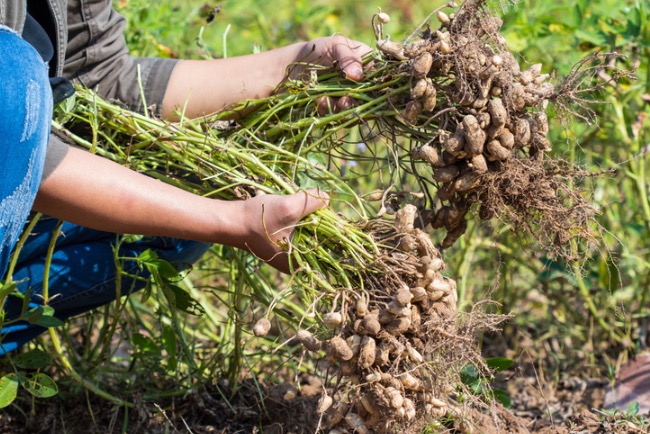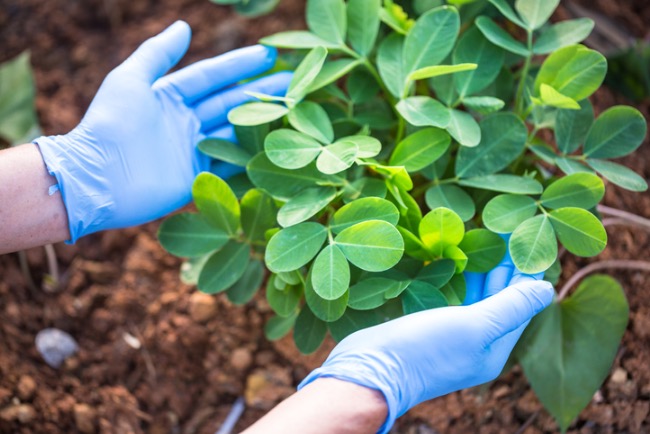

We may earn revenue from the products available on this page and participate in affiliate programs. Learn More ›
Peanuts are more than a delicious and filling snack. They’re also a valuable cover crop that can help your vegetable garden flourish. The humble peanut’s journey from foodstuff to soil booster is a fascinating one. Here, learn how one former slave used his agricultural expertise to pioneer the promotion of sustainable growing practices using the crop, and find out how you can use peanuts in your garden for a bountiful harvest.
Why Use Cover Crops?
Cover crops, also known as green manures, are an alternative to traditional fertilizers, such as animal manure. They keep weeds down, prevent erosion, and help reduce the spread of soil-borne disease. When it’s time to plant a regular garden crop, the green manure is turned into the soil to add nutrients and improve the soil’s condition, making it an ideal host for newly planted vegetables. While there are plenty of cover crop options to choose from, the use of peanuts for this purpose was popularized by George Washington Carver, a former slave who became a brilliant agricultural scientist.

George Washington Carver: A Peanut Pioneer
Carver, born in Missouri just before slavery was abolished, used his expertise in botany to develop sustainable farming techniques with the intention of helping poor Black farmers in the South. Carver saw these farmers struggle post-emancipation to grow much of anything in soil depleted of nutrients. Black farmers living in a Jim Crow-era South were forced into debt and kept from owning land. With commercial fertilizers financially out of reach for these farmers, Carver sought to find and share alternative, accessible ways to improve soil health. He believed that practices like the use of cover crops could help destitute farmers boost their soil’s nutrient content without having to shell out the little money they had for expensive fertilizers.
Carver found that peanuts were an ideal cover cropping choice for southern climes, thanks to their affinity for warm, humid weather. Carver’s work in the field of agriculture remains important today. His altruistic approach to farming science shows how much we can learn as growers and stewards of the earth when we freely share our knowledge. He also showed us that peanuts have hundreds of uses, including in the garden.
RELATED: How to Plant a Vegetable Garden
Using Peanuts to Boost Soil Health
Peanut butter sits among other nut butters in the supermarket aisle, but the tasty nut bursting with distinctive flavor is actually a legume. Carver understood that what makes the peanut plant so well suited to cover cropping duties is its nutrient-boosting powers. Instead of gobbling up nitrogen like other plants, legume roots return this vital nutrient to the soil. As peanut plants decompose, the dead and decaying matter also releases nitrogen, leaving behind plenty of food for the next hungry crop. Cover crops, including peanuts, also improve the condition of the soil. The soil becomes fluffier, making it better at retaining moisture and letting root systems breathe.

RELATED: 10 Biggest Vegetable Gardening Mistakes
How to Plant This Cover Crop
Peanuts do best in sunny, hot, and humid weather, but the plants can also tolerate partial shade. Well-drained soil is ideal because peanut roots don’t like to be waterlogged. Plant this cover crop in the spring to ensure it has enough time to grow. Because peanuts require up to 160 days to mature, depending on the variety, know that the area where you plant them will be out of commission for a chunk of the growing season. Use crop rotation practices—another sustainable gardening technique favored by Carver—and plant this cover crop in a different bed each year to maintain soil health throughout your garden.
Inoculating seeds with a bacteria called Rhizobium helps improve the nitrogen-fixing capacity of legumes like peanuts. You can buy it in powdered form and sprinkle it on moistened seeds before planting. Plant the treated seeds in rows about 12 to 24 inches apart. Hilling (mounding the dirt) at the base of the plants helps improve root spread underground. Much like potatoes, peanuts are harvested once the foliage yellows, by pulling the plant root system up from the ground. Till the remaining plant matter back into the soil to further boost nitrogen levels.
